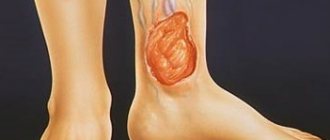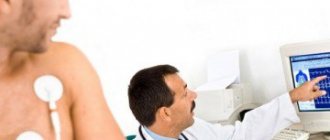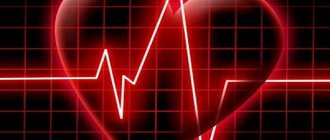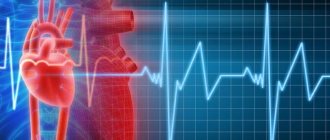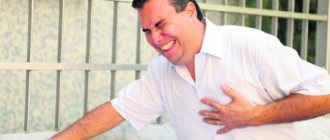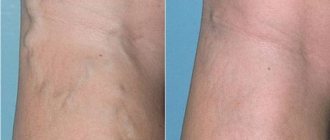With repeated myocardial infarction, a clot occurs in one of the arteries supplying the heart muscle with blood. In this case, the cells die, and subsequently a scar consisting of connective tissue forms in their place. This disease occurs after one or more heart attacks as a manifestation of an ongoing atherosclerotic process.
Features of recurrent MI
Repeated myocardial infarction, as mentioned earlier, occurs after the lesion has completely healed after the first attack. Its clinical picture is influenced by a number of factors:
- duration between the first and second attacks;
- the size of the new myocardial lesion;
- initial state of the heart muscle.
The course of the recurrent disease is more severe than the primary one. Acute and then chronic forms of heart failure develop. An atypical course of the disease often occurs: an asthmatic variant of a heart attack occurs, or it manifests itself in various forms of arrhythmia. Diagnosis of recurrent myocardial infarction using electrocardiographic examination is very difficult.
False normalization of the ECG is sometimes observed. A positive T wave may appear on it instead of a negative one, or the S–T interval may stretch into an isoelectric line. To identify the localization of focal changes, several ECG sessions are performed, and then a comparative analysis of the results is done using data from the previous disease. If, based on ECG comparison, repeated myocardial infarction is in doubt, then an accurate conclusion about the presence of new lesions of the heart muscle is confirmed by conducting a thorough analysis of the clinical picture of the disease, comparing blood tests, the patient’s condition, body temperature, and symptoms.
What is the Buteyko method and how to master it?
In 1952, the Soviet scientist-physiologist Konstantin Pavlovich Buteyko made a revolutionary discovery in the field of medicine - Discovery of deep breathing diseases
. Based on it, he developed a cycle of special breathing training that allows you to restore healthy, normal breathing. As the practice of thousands of patients who have passed through the Buteyko Center has shown, the normalization of breathing itself forever eliminates the need for medications for patients with the initial stages of the disease. In severe, advanced cases, breathing becomes a huge help, allowing, together with drug therapy, to save the body from the unstoppable progression of the disease.
In order to study Dr. Buteyko’s method and achieve a significant result in treatment, the supervision of an experienced methodologist is necessary.
. Attempts to normalize breathing on your own using materials from unverified sources are, at best, unsuccessful. It is necessary to understand breathing - a vital function of the body. Establishing healthy physiological breathing is of great benefit; improper breathing is extremely harmful to health.
If you want to normalize your breathing, apply for a distance learning course in the Buteyko method via the Internet. Classes are held under the supervision of an experienced methodologist, which allows you to achieve the desired result in the treatment of the disease.
Chief physician of the Center for Effective Training in the Buteyko Method, neurologist, chiropractor Konstantin Sergeevich Altukhov
Causes of recurrent MI
With an individual tendency to form blood clots in blood vessels, a new attack of the disease may occur in the following cases:
- Stop taking medications. Medicines prescribed by a doctor after the first attack of the disease are aimed at relieving pain in the heart area, and most importantly, preventing the formation of new blood clots and changes in vascular tissue. The patient, feeling better, voluntarily stops taking them or reduces their dosage, which absolutely cannot be done.
- Non-compliance with diet. Proper nutrition not only contributes to recovery from the injury, but also prevents the occurrence of recurrent myocardial infarction. Eating fatty, salty, spicy, fried foods leads to the formation of blood clots and blockage of blood vessels. It should be remembered that you need to stick to a diet for the rest of your life.
- Bad habits. A person who has had a heart attack and continues to smoke and drink alcohol has a high probability of having a recurrent MI.
- Physical activity. Heavy loads force a diseased heart to work under strain, so it is not recommended to engage in sports disciplines that require great effort. Moderate physical activity has a beneficial effect on the recovery processes of the heart muscle. It is recommended to perform therapeutic exercises, take long walks, and perform aerobic exercises to prevent recurrent myocardial infarction.
- Emotional condition. Frequent stressful situations, endless worries and worries about any reason also contribute to a repeated attack. During stress, the myocardial need for oxygen increases due to an increase in heart rate, and due to impaired circulation in the coronary vessels, this is not desirable, so it is necessary to avoid unnecessary mental trauma.
- Change of climatic conditions. After suffering from an illness, it is not advisable to suddenly change the climate, so as not to provoke unfavorable physiological reactions of the body.
All causes of repeated myocardial infarction are related to the patient’s lifestyle and compliance with the recommendations of the treating doctor, so the disease can be prevented and avoided.
Therapy methods
Treatment for a second heart attack is no different from that for the first attack. If less than 12 hours have passed since the onset of the attack and there are no contraindications, thrombolytic therapy is prescribed. It consists of administering a drug that breaks up a blood clot in a coronary vessel. This treatment is very effective.
An anesthetic injection may also be given to relieve unpleasant symptoms. The patient is given a drip with a blood-thinning drug, which also allows the blood clot to dissolve. The patient must remain in the hospital for several days. If more than 12 hours have passed since the onset of the attack and there is a high likelihood of complications, surgery may be required.
To avoid negative consequences after a heart attack, stenting can be performed. It is recommended to carry out it 1-2 hours after the onset of unpleasant symptoms. In this procedure, a compressed stent (mesh metal tube) is delivered to the blocked heart artery. At the site of thrombus formation, this stent is expanded.
Due to this, blood flow is restored in the area of the vessel, and its walls do not close. Sufficient oxygen is supplied to the affected heart so that the heart attack stops.
After such an operation, the patient can be discharged on the second day. The likelihood of a recurrent heart attack after stenting is very low, provided that all medical recommendations are followed.
Symptoms of recurrent MI
The patient must be very attentive to his health in order to notice the signs of MI in time. They do not at all coincide with those in the first case. The patient appears:
- acute short-term pain in the chest, radiating to the neck and lumbar region;
- nausea and vomiting;
- sticky dermis;
- dizziness and vomiting:
- drowsiness and weakness;
- general malaise;
- dry hacking cough;
- heaviness in the chest;
- various forms of arrhythmia.
For any of the above symptoms of recurrent myocardial infarction and abnormalities in health that differ from normal, and even not related to the work of the heart, an individual who has already had a heart attack should consult a doctor and undergo an examination so as not to miss a recurrence of the disease.
Pleasant emotions and positive impressions
Learn to create a good mood for yourself and those around you. It’s not difficult, the main thing is to try to find positive aspects in all situations and enjoy every, even minor, event in life. Most people who “saw death on the threshold”, during the first heart attack, as a rule, begin to appreciate their, albeit imperfect and far from cloudless life. Positive emotions have a beneficial effect on overall health and the functioning of the heart muscle. And many modern scientists believe that a good mood, positive emotions and pleasant impressions are the best prevention of a heart attack.
Diagnostics
To make a diagnosis of recurrent MI, the following is used:
- ECG diagnostics – difficulties often arise due to persisting changes after a previous illness.
- Laboratory tests - determination of the concentration of troponins in the blood. Evaluation of the results of measuring this indicator makes it possible to differentiate severe pain in the chest in case of acute recurrent myocardial infarction.
- Echocardiography - with its help, new foci of myocardial damage are identified and the function of muscle contraction is assessed.
- Coronary angiography - allows you to conduct a study of the patency of the vessels feeding the heart.
Why is an ECG performed for hypertension?
- ECG interpretation
- Diagnosis and ECG indications for hypertension according to the stages of disease progression
- Useful tips
The ECG has long been a reliable assistant in the study and treatment of hypertension. This instrumental diagnostic method, required for every patient with hypertension, identifies interruptions in the functioning of the heart, determines the presence of angina, provides data on the condition of the myocardium, cardiac hypertrophy, and displacement of its electrical axis.
To decipher an electrocardiogram means to evaluate the efficiency of the heart muscle and its potential. This allows the doctor to detect rhythm disturbances, ischemia and other abnormalities.
A more detailed picture of heart deformations in hypertension is demonstrated by echocardiography. With its help, you can see hypertrophy plus measure the thickness of the ventricular wall, which tends to increase with increasing vascular resistance.
ECG interpretation
Decoding the cardiographic pattern involves measuring the length, area of the segments and amplitude of vibration of the teeth.
The rhythm of contractions of the heart muscle is calculated by the duration of the intervals. If their duration is the same or varies by no more than 10%, the indicators are normal; with other data, the possibility of rhythm disturbance is possible. But an objective diagnosis can only be made by the attending doctor.
The most obvious indicators of hypertension on the electrocardiogram are:
- Overload or hypertrophy of the left ventricle;
- Indirect symptoms of coronary heart disease or ischemia of myocardial areas.
Diagnosis and ECG indications for hypertension according to the stages of disease progression
Stage I
The onset of hypertension is accompanied by a small number of unstable symptoms that arise quickly and also disappear suddenly.
High blood pressure is sometimes detected by chance. Blood pressure tends to jump sometimes due to physical or emotional stress.
At this stage of the disease there is no target organ damage. Accordingly, the electrocardiogram, echocardiogram and radiograph do not demonstrate pathological metamorphoses.
Stage II
The next period of hypertension is characterized by a certain set of its manifestations; patients sometimes experience hypertensive crises.
The ECG shows changes characteristic of left ventricular hypertrophy. They are also visible on X-ray and echocardiographic examination. Later, the ECG for stage 2 hypertension will reflect data on disturbances in the rhythm and conduction of the heart, as well as coronary circulation.
Stage III
The highest stage of hypertension is determined by constant high blood pressure, plus complications develop in various organs:
- Brain: hemorrhage in the area of the cerebral cortex or cerebellum;
- Fundus: retinal hemorrhage;
- Heart: left ventricular failure, myocardial infarction;
- Kidney: renal failure.
An ECG reveals damage to the coronary circulation and manifestations of left ventricular hypertrophy.
Useful tips
It is possible to avoid the progression of hypertension if you follow the recommendations:
- Be sure to do physical exercise daily to keep your blood vessels elastic;
- It is necessary to maintain optimal weight, because excess weight tends to provoke both hypertension and coronary heart disease;
- It is important to avoid smoking, including passive smoking, since exposure to nicotine leads to blockage of blood vessels;
- Mandatory proper rest with alternating intellectual and physical activity is required;
- It is necessary to do tests for sugar from time to time;
- It is important to measure blood pressure at regular intervals;
- It is required to undergo an ECG of the heart within the time frame prescribed by the doctor.
To prevent hypertension from developing, it is necessary to identify it as early as possible. The most reliable and at the same time accessible and informative method, which makes it possible to diagnose the disease in a timely manner, is constant monitoring of blood pressure and heart function. An ECG will allow you to determine the root cause of changes in pressure - whether it is related to the functioning of the cardiovascular system or not - and prescribe the correct treatment in time.
Treatment of recurrent MI
The main task of the treatment process is to restore blood flow in the damaged vessel. A patient with repeated myocardial infarction (ICD-10 code I 22) must be hospitalized and undergo the following treatment:
- Medication. It is prescribed from the first day of the disease and includes the following groups of drugs: nitrates, statins, ACE inhibitors, anticoagulants, antiplatelet agents, beta-blockers.
- Thrombolysis is the administration of drugs to dissolve a blood clot.
- Balloon angioplasty - blood flow in a damaged vessel is restored. To do this, a catheter with a balloon is inserted into the vessel; when it inflates, it expands the lumen, and blood begins to flow into the damaged area.
- Coronary artery bypass surgery - surgical intervention is performed, a bypass vessel is placed, thereby restoring the impaired blood flow.
After discharge from the health care facility, treatment continues at home.
Repeated infarction of the inferior myocardial wall
This is an acute abnormal condition accompanied by necrosis of cells located along the lower wall of the myocardium. It occurs due to a lack of oxygen due to blockage of the right coronary artery by a thrombus. Failure to restore blood flow within half an hour can result in death. The disease most often affects people between forty and sixty years of age. Just after the age of forty, an increase in the formation of atherosclerotic plaques is observed. The following factors contribute to this:
- cardiac ischemia;
- previous heart attack;
- bad habits: smoking and alcoholic drinks;
- obesity;
- hypertension;
- little physical activity.
Genetic predisposition is of particular importance in the development of this disease. The severity of symptoms of recurrent lower myocardial infarction depends on the number of layers of the lower myocardial wall affected. Often the disease manifests itself acutely and is accompanied by the following symptoms:
- severe chest pain radiating to the arm;
- dyspnea;
- the occurrence of an attack at night or early in the morning;
- increased sweating;
- the emergence of a feeling of fear;
- a gastric or bronchial variant of the course of the infarction is possible.
The development of the disease and prognosis depend on the timely provision of medical care, the physical condition of the patient and the time that has passed since the first attack of myocardial infarction.
Consequences of a heart attack
After a secondary MI, various complications often occur. Most often, the consequences of repeated myocardial infarction can be:
- Heart rhythm disturbances occur in almost all patients.
- Heart failure - appears several months after the illness and is associated with a violation of the pumping function of the heart. As a result of this pathology, blood stagnation occurs in various organs and tissues, followed by hypoxia. The disease has the following symptoms: cough, shortness of breath, dizziness and general weakness.
- Cardiac aneurysm - thinning of a section of the heart muscle occurs, and contractility is lost. The patient's heart rhythm is disturbed, shortness of breath appears, the heart rate increases, and attacks of cardiac asthma occur.
- Cardiogenic shock - the contractility of the heart muscle sharply decreases. The blood supply to vital organs is disrupted. As a result, the pressure drops sharply, the extremities become cold, oliguria occurs, the heart rate increases, weakness, pulmonary edema and fainting are possible.
- Thromboembolic complications - cause abnormal processes in the body in the form of circulatory disorders and the occurrence of inflammatory processes.
- Heart rupture is rare and leads to instant death of a person.
To prevent recurrent myocardial infarction, it is necessary to lead a healthy lifestyle, eat well, and take medications prescribed by your doctor.
Complications and prognosis
A repeated attack is dangerous due to the possibility of developing complications. After this, the following often occur:
- Acute heart failure.
- Pulmonary edema.
- Cardiogenic shock.
- Heart rhythm disturbances.
- Ruptured left ventricular aneurysm.
You can avoid the development of such conditions if you consult a doctor in time if you have heart pain, constantly take prescribed medications and regularly undergo a cardiogram.
The prognosis for recurrent infarction depends on the size of the lesion. With small focal necrosis, the prognosis is more favorable than with a large infarction. In the latter case, complications often develop leading to the death of the patient.
With large focal lesions, 20% of patients die within two weeks. Men over the age of 60 die in 15% of cases, and women over 70 – in 20%.
Recovery after secondary MI. Advice from a cardiologist
The recovery process after repeated myocardial infarction begins in the hospital under the supervision of doctors and continues after the patient is discharged. During this period, the individual's goal is to gradually regain physical capabilities and reduce the risk of complications. For this you need:
- Exercise stress. In the first days after returning home, the patient is advised to rest more, and use stairs or short walks as physical activity. Every day you should gradually increase physical activity over several weeks and strictly monitor your state of health. Advice from a cardiologist will help you create a cardiac rehabilitation program. It may include a variety of exercises, but preference is given to aerobic activities, which strengthen the heart, improve blood circulation and lower blood pressure. The patient is allowed to ride a bicycle, walk quickly and swim.
- A lifelong necessity. For people who have had a heart attack, cardiologists advise constantly taking two groups of drugs: antiplatelet agents, which affect blood clotting and suppress the formation of blood clots, and statins, which lower cholesterol levels. This is especially necessary for patients who have had a stent placed. Some patients, for their own reasons, stop taking these important medications, and then a recurrent myocardial infarction occurs after stenting, which ends in death.
- Diet. Changing your diet helps reduce the risk of complications and subsequent heart attacks. It is advisable to eat vegetables and fruits every day. They contain minerals and vitamins. To reduce blood cholesterol, you need to prepare dishes from herring, mackerel, sardines, salmon, eat seeds, nuts, olive oil and the overseas fruit avocado. In addition, cardiologists recommend consuming table salt in minimal quantities. This will help reduce the likelihood of many ailments.
Doctors have learned to treat MI, and for patients it often goes unnoticed. It is important to remember that the process of formation of plaques in blood vessels and blood clots on them does not stop after the patient’s recovery. For those who have suffered a primary and, especially, repeated MI, the risk of developing a subsequent attack is very high.
Types of pathology
The second time, the patient may experience a recurrent or repeated infarction. These attacks have one difference.
Recurrent myocardial infarction is an attack that develops over several months after the previous one; it occurs in the acute period.
A second heart attack may occur later than two months later. The outbreak may be in the same place as the first one, or have a different location. There are extensive and small focal infarctions.
Such cases are not uncommon, which is associated with patients’ non-compliance with doctor’s instructions in the acute period. Relapses are observed in 40% of patients. The risk of a recurrent attack is highest in the first days after a heart attack.
It is advisable for people at risk to be registered with a cardiologist for a year.
First aid for recurrent MI
If a person experiences pain in the chest, heavy sweating, heart rhythm disturbances, or general malaise, you should give him a Nitroglycerin tablet and immediately call an ambulance.
We must remember that the sooner qualified medical care is provided for recurrent myocardial infarction (ICD-10 code I 22), the greater the chances of successful treatment. The patient must be hospitalized and undergo a cardiogram. It would be good to be able to compare the results with previous research. Using existing methods, cardiologists can immediately restore blood flow through the affected artery, reducing myocardial damage. To do this, special medications are used to help dissolve blood clots, or angiography is performed followed by stenting of the damaged vessel. Both methods give a positive effect only in the first hours after the onset of an attack. This once again suggests that the patient needs to be urgently taken to a medical facility, and not wait until the end of the attack.
How to act
Preventing a second or third heart attack is very valuable to a person's life. It is important to provide assistance as quickly as possible.
When the first signs of a recurrent heart attack occur, you must act as follows:
- help the patient take a quiet lying position,
- remove clothes that prevent you from breathing freely,
- call emergency help,
- give the person a nitroglycerin tablet under the tongue,
- give an aspirin tablet,
- after 5 minutes give another nitroglycerin.
This is first aid. If provided in the first minutes after the condition worsens, an attack can be prevented.
If the patient's condition worsens, but the ambulance has not yet arrived, artificial respiration and chest compressions can be performed. However, such manipulations can only be carried out if you have special skills. Otherwise, you can cause irreparable harm to a person.
Prevention of recurrent MI
To prevent recurrent and repeated myocardial infarction, the following measures are recommended:
- Healthy eating. As a result of poor nutrition, atherosclerosis often develops with the formation of blood clots in the blood vessels, which can enter the heart cavity with the blood flow. Therefore, it is necessary to remove cholesterol-rich foods from your diet and eat more plant foods.
- Drug treatment. Therapy carried out in a medical institution does not end when the patient is discharged. He must always take without fail all the medications prescribed by the doctor. Otherwise, a third heart attack is possible.
- Physical activity. To prevent recurrent myocardial infarction, you should give up exhausting exercises, and switch to physical therapy classes and take long walks in the fresh air.
- Monitor your body weight and prevent obesity.
- Give up bad habits - smoking and alcohol.
- Constantly monitor blood pressure.
- Eliminate stressful situations.
The quality of life will become much higher if you pay attention to your health and follow your doctor’s recommendations.
The doctor does not explain to the patient the importance of taking medications, does not negotiate with him
“A doctor who cares for a patient after a heart attack cannot limit himself to just prescribing certain medications,” says Simon Matskeplishvili. — It is necessary to clearly explain why we give medications that thin the blood and lower cholesterol. If the patient understands the importance of taking these medications, he will take them, even if he feels normal.
“The issue of treatment is not a matter of the doctor prescribing medications and the patient’s unquestioning compliance with these recommendations,” adds Alexey Erlikh. - This is a matter of agreement - and this is precisely what many doctors and patients do not know how to do.
Here's an example. We tell the patient that after a heart attack physical activity is necessary and he must walk 10 km a day. He objects: I can only walk 5 km a day. Okay, we say, let's add swimming twice a week - how do you feel about that?
If the patient says that he cannot take that many tablets, we begin to combine, look for drugs where there are two or even three or four drugs in one tablet.
In turn, the patient’s task is to find his doctor, one whom he can ask if he does not understand (rather than looking for an answer on the Internet), whom he can call if new questions arise, whom he will trust and whom he will listen to.
Today, much has been achieved in Russian healthcare to save the lives and preserve the health of patients with acute coronary syndrome: the number of regional vascular centers has increased, the number of coronary interventions for ACS is growing, and drugs have been introduced to prevent the formation of blood clots. It's up to the patients and their doctors who have not yet kept up with technology - they do not understand the need to take medications, and they neglect measures to prevent cardiovascular diseases. It is always difficult to perceive new information and change your picture of the world - but in the case of myocardial infarction it can cost your life.
